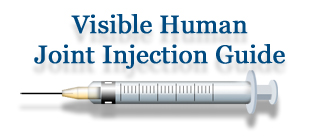The systematic physical examination and injection therapy of joint regions requires psychomotor skills based on a thorough understanding of the anatomical components, the palpable landmarks, their interactions and the functional effects of contraction of specific muscle groups (ie the "functional anatomy"). The anatomy knowledge base learned in gross anatomy needs to be translated into a working clinical anatomy knowledge for accurate diagnosis with physical examination and successful treatment with injection therapies.
Localized sites of pathology in the shoulder region typically produce pain with specific types of motion and are often worse at night. The typical sites of pathology can be localized by palpation of specific anatomic landmarks and the diagnosis confirmed by reproduction of the pain with physical examination maneuvers that put stretch or pressure on the painful anatomic structure.
For example, the shoulder pain due to Supraspinatus Tendonitis can be diagnosed by finding tenderness over the Greater Tubercle of the Humerus (the insertion site of the Supraspinatus Tendon) and the augmentation of the pain by "resisted abduction at 30 degrees".
This guide will provide a practical resource for increasing your confidence in joint injections. It will create a foundation for building and perfecting your knowledge of shoulder anatomy. The following lesson begins your journey into the Visible Human Joint Injection Guide.
Lesson One: Structural Anatomy of the ShoulderLesson Two: Functional Anatomy of the Shoulder
Lesson Three: Physical Examination of the Shoulder - Part One
Lesson Four: Physical Examination of the Shoulder - Part Two
Lesson Five: Physical Examination of the Shoulder - Part Three
